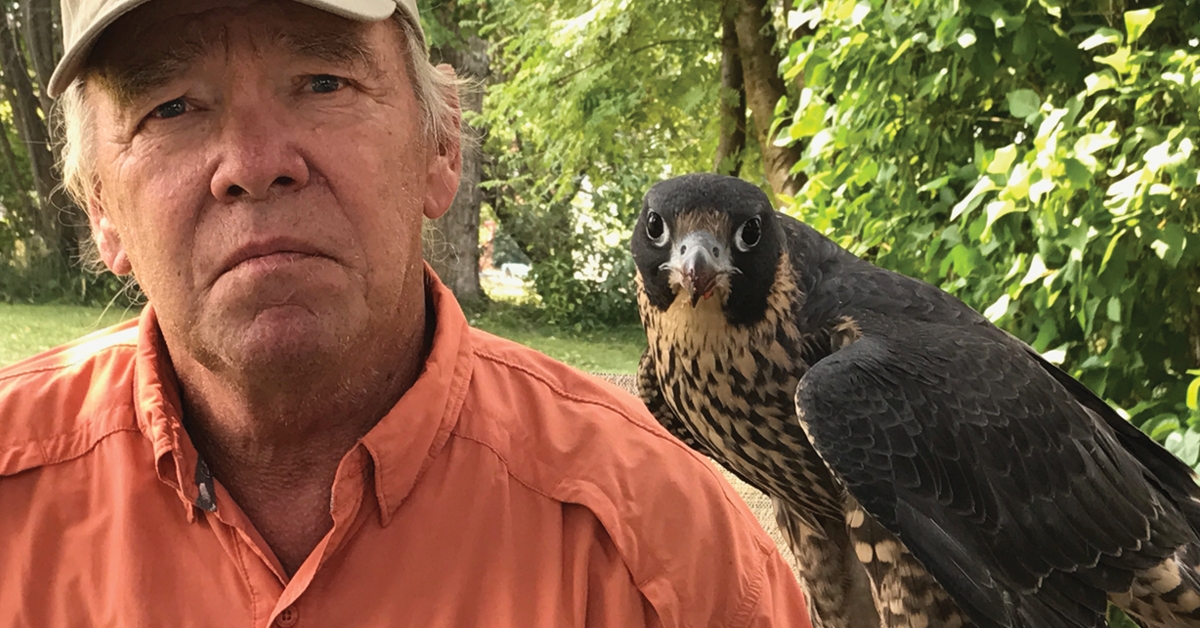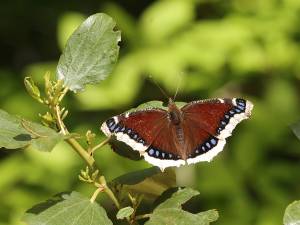by GAIL JOKERST
If you grew up hearing the phrase, “Faster than a speeding bullet,” you know it describes none other than Superman. Given an equal measure of poetic license, those same words could also describe the American Peregrine Falcon as well as the Man of Steel or any other fictitious hero.
Falco peregrinus anatum may not be faster than a dispatched full metal jacket. It is, widely deemed to be the swiftest animal on the planet. Additionally, it is gifted with eyesight 10 times sharper than a human’s.
From a flying height of 1,000 feet, this sleek hunter can spot even a mouse on the move, though its favorite prey are winged—shore birds, song birds, and game species. Plunging into a vertical dive, called a stoop, and clenching its talons, the peregrine streaks towards its target at speeds clocked between 180 and 240 mph. According to Jay Sumner, a falconer and raptor researcher, the impact of the blow approximates a 600-pound weight falling from the sky.
“Nothing compares to seeing peregrines go into a stoop. It’s a beautiful thing to watch,” said Sumner, who hunts ducks and pheasants with his peregrine named Ava. “Humans have been infatuated with peregrines for eons, long before Medieval times. They’re the most noble bird on the planet because of their looks, speed, and agility.”
Like ospreys, peregrines inhabit—at least for part of the year—every continent except Antarctica. In Montana, as elsewhere, waterside cliffs have long been a destination for nesting pairs.
Come autumn, most peregrines head south to locales ranging from Texas to South America as they follow their food supply.
Some peregrines, however, prefer to take up residence atop places like Seattle skyscrapers and stay put. Since pigeons—their dietary mainstay—never leave town, neither do they.
Sumner’s fascination with birds of prey began during childhood when he and a friend spotted a great horned owl flying to and from its nest. Afterwards, he read everything he could find on raptors, including National Geographic features written by the legendary Craighead brothers, John and Frank, both accomplished falconers. Their writings inspired Sumner to search his own proverbial back yard for signs of peregrines. Sure enough, in 1961 the teenager pinpointed a nest, also known as an aerie, on a cliff outside his home in Livingston.
“I found it by the Yellowstone River five miles south of the highway,” he said. “It was just two wing flaps from the nesting cliff to the river,” recalled Sumner. “I saw the falcon dive, and it was such a neat thing to watch I was hooked forever. After that, I surveyed for new nests and found another one on Sacrifice Cliff over by Billings. From that point on, I knew I wanted to study raptors.”
In his excitement at locating his first aerie, Sumner contacted Dr. John Craighead, who was then researching grizzly bears in Yellowstone National Park.
Craighead drove up to Livingston to meet Sumner and offered to help him remove a chick from the nest and train it for falconry. Although illegal today without a falconry permit from Montana Fish, Wildlife, & Parks, at that time no restrictions applied.
“I was 18 years old, didn’t know beans about climbing, and I was scared. But I went down the cliff face anyway and got to the ledge about 20 feet below using a climbing rope. John secured the other end of the rope,” recounted Sumner, who became one of Craighead’s students at the University of Montana. “There were two young in the nest. I grabbed one by the legs with my bare hands. It screamed and hissed till I put it in a cloth sack, then it quieted quickly. I kept it for a week but didn’t know how to train it. So I gave it to John, who trained and flew it.”
Although peregrine populations are currently well established, that has not always been the case. During the 1940’s, peregrine numbers nationwide plummeted.
According to The Nature Conservancy, an estimated 3,875 nesting pairs were found in North America prior to the 1940’s. By 1975, only 324 pairs could be located.
The main culprit was the introduction of DDT. Insects that ate plants sprayed with DDT ingested the pesticide, then birds of varying sizes ate the tainted insects.
Because 95 percent of the peregrine’s diet consists of birds, the contaminant lodged in them as well. This resulted in laying eggs with thinned shells that could no longer withstand brooding pressure, ultra-violet light, or heat from the sun. Consequently, eggs cracked prematurely, and reproduction almost ceased.
Despite being placed on the Endangered Species List in 1970 followed by a 1972 ban on DDT, no nesting pairs could be found in the Treasure State into the early 1980’s.
Fortunately, the Peregrine Fund, a non-profit organization that protects threatened birds of prey worldwide, took action. They bred falcons in captivity for almost 20 years, releasing more than 550 young in Montana.
“Montana now has a healthy, expanding population with a high reproductive rate. It’s surprising how fast they’ve come back and how successfully,” remarked Sumner. But like other researchers familiar with the species’s migration to regions south of the border where DDT levels remain high, he doesn’t take their future well-being for granted.
“Peregrines are a barometer of the health of our environment. They’re so susceptible to toxins because of their diet,” noted Sumner. That’s one reason why he founded the Montana Peregrine Institute (MPI)—to ensure these raptors continue to thrive.
To assess the distribution and productivity of Montana’s peregrines, MPI coordinated peregrine surveys from 1998 to 2016 with the help of federal and state biologists. The results showed that the state’s population had increased from 18 nesting pairs in 1998 to over 100 by the end of the survey.
As part of MPI’s ongoing work, Sumner launched project “Montana Peregrine Watch” to annually check for nesting activity at all the territories that were identified during the 18-year survey period.
To do this calls for helpers, lots of them. Last year 80 people, mostly retirees, volunteered statewide. Admittedly finding peregrines in the wild is not an easy task, though it’s certainly a rewarding one.
“You’re looking for a two-pound bird on an 800-foot cliff. It’s hard to spot, but with one sighting, you get hooked. And each year volunteers gain more experience. It takes time and patience, an interest in birds, plus a pair of binoculars,” said Sumner. “But the peregrine sells itself when you see the young run around the ledges, exercising their wings and trying to balance themselves when landing after their first awkward flight.”
To become a Peregrine Watcher requires several visits to observe an assigned cliff and determine if it’s occupied and productive. That means two April visits to see if any adults have shown up, followed by late-June and mid-July visits to count chicks before they fledge.
If it sounds like an appealing challenge, contact Sumner. He’ll provide some initial training and a spotting scope plus all the encouragement you’ll need to witness a peregrine on the wing.
For more information, visit montanaperegrine.org; call Jay Sumner at 406-240-2766; or email him at [email protected]. You can also watch a peregrine webcam at: peregrinefund.org/webcam-peregrine. MSN









